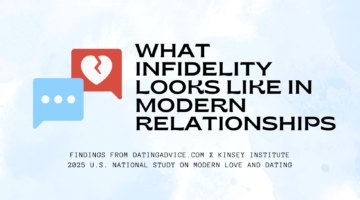How Alcohol Affects Sexual Consent Communication
September 17, 2025 by Emily Mendelson
Alcohol has long been known to act as a “social lubricant,” especially when it comes to the pursuit of sex and relationships. When people drink, they tend to feel less inhibited by social cues and, therefore, may feel less anxiety about flirting or approaching someone.
Although alcohol can facilitate communication in this way, the interaction of alcohol and sex is also a public health concern insofar as alcohol may also inhibit the clear and effective exchange of sexual consent. In this post, we’re going to discuss a recently-published article in The Journal of Sex Research that looks specifically at how communication of sexual consent changes for college-age adults when alcohol is involved. [1]
Alcohol-Involved Settings on College Campuses
The topic of sexual consent is particularly salient on college campuses. The frequency of partying or “going out,” the ease of drinking, and the centralized housing surrounding college campuses contribute to an atmosphere wherein students are frequently meeting new people and simply have more opportunities to hook-up. However, college campuses are also known to have a hookup culture that promotes or encourages casual sex more broadly.
This intersection of hookup culture and alcohol consumption yields several concerns around consent. For example, being intoxicated can affect individuals’ decision-making skills, and may increase the risk of sexual assault if people are unable to appropriately understand subtle consent (or non-consent) cues. However, this risk may be further increased for college students, many of whom are drinking underage and may feel pressure to (a) drink to the point of excess in party settings, and (b) pursue hookups while in those settings. This is not to say that college settings inherently create dangerous or unsafe hookup scenarios, but rather, it is particularly important to pay attention to how sexual consent may be affected in these contexts.
The Present Study
Building on their previous work on sexual consent, Jozkowski and Marcantonio (2025) conducted interviews with 30 college students to better understand communication during sexual encounters when alcohol was involved. Notably, participants were asked to reflect on consensual encounters, so stories about non-consensual sexual activity are not reflected in this specific work.
Overall, the stories from participants “described consent to alcohol-involved sex as a process and considered alcohol – alcohol-involved environments and consumption – both an integral part of their consent process and highly integrated into the process itself” (p. 5). In other words, participants heavily considered the context of “alcohol-intensive environments” (e.g., bars, parties) when considering sexual consent, and accounted for the implications of drinking alcohol in those settings. Below, we’ll describe a few specific findings from this study, including the idea of “pre-consent” and different consent cues related to alcohol-involved sex. [1]
“Pre-Consent” in Alcohol-Intensive Environments
Earlier, we discussed how (a) party culture and hookup culture are pervasive on college campuses, and (b) the way alcohol facilitates the pursuit of sexual and/or romantic interests. So what are the implications of this for consent? Participants in this study “alluded to being in an alcohol-intensive environment as suggestive of a form of preemptive consent,” which the authors describe as a form of “pre-consent.” Pre-consent does not describe actual consent indicators to sexual activity, but refers to a willingness to potentially be open to sexual activity later that evening. In this way, “alcohol-involved environments were where people went to meet one another with the explicit or implicit intent to have sex and thus perceived being in an alcohol-involved environment as a potential indicator of consent” (p. 6). In other words, by virtue of simply being in these environments, others may assume that someone already has some interest or willingness to have sex.
This finding echoes earlier work by Hirsch and Khan (2020) who considered “sexual geographies” when theorizing factors that contribute to sexual assault on college campuses. Specifically, sexual geographies “encompass the spatial contexts through which people move, and the peer networks that can regulate access to those spaces.” (p. xix). [2] In the context of alcohol-involved environments on college campuses, the proximity of individuals in age, geographic location, and shared identity as college students—and at the same college no less—make it so these environments become spaces that individuals conflate with sexual activity. Someone’s presence at an alcohol-involved environment signaled to participants a potential interest in sex, which is not to be replaced with the communication of sexual consent itself.
Consent Cues in Alcohol-Intensive Environments
When building to sexual activity, participants described a number of consent cues that allowed them to feel better-informed about someone else’s sexual interest. Participants described how socializing with others in the presence of alcohol oftentimes was interpreted as an “initial consent” cue, especially when this socializing came in the form of flirting and suggestive touch (p. 6). While being in an alcohol-intensive environment may have served as pre-consent, specific forms of socializing while drinking alcohol in these environments were then interpreted as initial consent. Notably, however, the researchers clarify that “participants often described assessing a potential partner’s sexual interest as an early indicator of potential consent, conflating sexual interest and consent” (p. 6). [1]
While socializing in the presence of alcohol, agreeing to go to a second location alone with another person was also understood as a consent cue. Participants described that an invitation to “hang out” at someone’s place after a party, and the subsequent agreement to do so, were pretty clear suggestions of sexual interest.
In other words, participants seemed to view consent as a sequential process, beginning with pre-consent, followed by initial consent, followed by other cues and indicators of consent. However, they did not interpret these as replacements for formal consent immediately prior to sex; they still saw it as being necessary to communicate that explicitly. But in terms of determining whether consent was present, participants also mentioned the importance of reflecting back on the encounter while sober, which suggests recognition that they aren’t always seeing things clearly when under the influence.
Key Takeaways
Previous research has found that individuals still feel confident when communicating under the influence, despite the fact that alcohol is well-known for impairing decision-making. [3] In the new study, participants were clear that, even in the presence of alcohol, previous consent cues were not a substitute for clear consent communication. They recognized an explicit need to still communicate sexual consent prior to sexual activity taking place.
Overall, the results from this study demonstrate that there is a need to better understand sexual consent in the presence of alcohol, and a continued need to distinguish potential indicators of sexual interest with sexual consent itself.
If you have a sex question of your own, record a voicemail at speakpipe.com/sexandpsychology to have it answered on the blog or the podcast.
Want to learn more about Sex and Psychology? Click here for more from the blog or here to listen to the podcast. Follow Sex and Psychology on Facebook, Twitter (@JustinLehmiller), Bluesky, or Reddit to receive updates. You can also follow Dr. Lehmiller on YouTube and Instagram.
Image made with Canva.
References
[1] Jozkowski, K. N., & Marcantonio, T. L. (2025). Navigating consent during alcohol-involved sex: A qualitative study examining alcohol consumption and the sexual consent communication process. The Journal of Sex Research. Advance online publication. https://doi.org/10.1080/00224499.2025.2473967
[2] Hirsch, J. S., & Khan, S. (2020). Sexual citizens: A landmark study of sex, power, and assault on campus (First Edition). W.W. Norton & Company.
[3] Jozkowski, K. N., Marcantonio, T., Willis, M., & Drouin, M. (2023). Does alcohol consumption influence people’s perceptions of their own and a drinking partner’s ability to consent to sexual behavior in a non-sexualized drinking context? Journal of Interpersonal Violence, 38(1–2), 128–155. https://doi.org/10.1177/08862605221080149

Dr. Justin Lehmiller
Founder & Owner of Sex and PsychologyDr. Justin Lehmiller is a social psychologist and Research Fellow at The Kinsey Institute. He runs the Sex and Psychology blog and podcast and is author of the popular book Tell Me What You Want. Dr. Lehmiller is an award-winning educator, and a prolific researcher who has published more than 50 academic works.
Read full bio >


